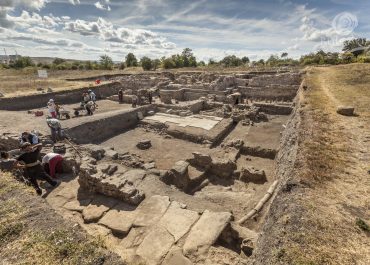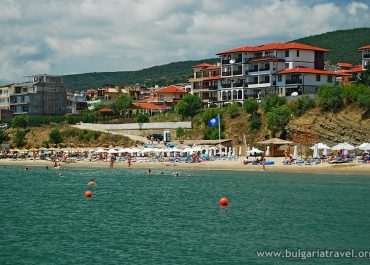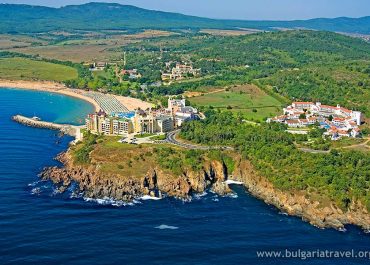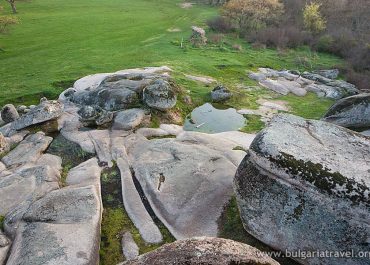
Pomorie
Pomorie is located in the southern part of the Bulgarian Black Sea Coast, 22 km away from Burgas and approximately 400 km away from Sofia. The population of the town is around 14 000 people. E87 main road connecting the northern and the southern parts of the Black Sea Coast passes through Pomorie. Varna, Burgas, Sozopol, and Nesebar can be reached via Pomorie Port. The town lies in close proximity to the international airport of Burgas.
Pomorie is one of the most popular destinations in summer– the average air and water temperature in July is 23.6°С, there are up to 2 360 hours of sunshine every year, and the beach is about 5 km long. Winters are mild and with minimum precipitation.
Moreover, the region has been famous for the medicinal qualities of the mud extracted during the production of salt in Pomorie Lake ever since ancient times. The healing powers of the mineral water in the town are also well-known. The slow cooling of the seawater is very typical for the region. In the morning before sunrise, the air is rich in ozone, negative ions, ultraviolet rays and iodine released in gas form by seaweed.
The earliest evidence of human activity found in Pomorie dates back to the Neolithic Age (6th millennium BC). There are also traces from the Chalcolithic Age (5th millennium BC), the Bronze Age (3rd – 2nd millennium BC) and the Iron Age (end of the 2nd millennium BC). In the 2nd century BC, Pomorie was named Anchialus. In 45, Anchialus became part of the Roman Empire. The town expanded during the 2nd century when it was moved to a new place (in Paleocastro Area). The period during which Anchialus was part of the Roman Empire was marked by powerful progress. The economic and political development of the town was proven by the fact that it started to mint coins.
The nymph cult was extremely widespread during this period. According to local people, the so-called Anchialic nymphs were three girls who inhabited the mountains, the forests and the rivers. They were regarded as goddesses – protectors of springs. This cult was related to the nearby Aqua Kalide mineral springs – the modern-day Burgas mineral baths which were called Anchialus baths. The town was visited personally by the rulers of the Roman Empire, as great celebrations were held on 28 October 294 in honour of the visit of Emperor Diocletian.
The town retained its strategic position in the Middle Ages. Oftentimes its region became a scene of violent battles between the Bulgarians and the Byzantines and the control over the town switched many times from one camp to the other. In 1453, Anchialus was conquered by the Ottomans. During the second half of the 18th century and the first half of the 19th century, the coastal town functioned as an administrative centre. The town was liberated from the Ottoman rule on 7 February 1878.
Anchialus continued to develop after the Liberation – the local people engaged in vine-growing, wine production, fishing, salt production, etc. The production of salt has always been very important for the Pomorie Region. Fishing also plays a significant part in the livelihood of people and the economy of the town. Crafts and trade by sea were developed predominantly. In 1934, Anchialus was renamed to Pomorie.
A considerable part of the finds discovered during archaeological digs in the region can be seen at Pomorie History Museum. The archaeological exhibition is spread around several halls. The main part of the finds is displayed in the Prehistory Hall. They date back to the Chalcolithic Age (5th millennium BC) and were discovered in Kozareva Settlement Mound. Many of the items exhibited in the Antiquity Hall were found on the bottom of the sea, while the Roman and medieval town of Anchialus is represented by artefacts discovered during excavations in Paleocastro Area. There is a special museum hall devoted to coins. The oldest exhibits displayed in the Numismatics Hall are from Greek coastal poleis, coins of Thracian and Macedon kings (5th – 1st centuries BC). Central spot is given to the bronze coins minted in Anchialus during the Roman Age and to medieval Bulgarian coins.
On the second floor, visitors can see the traditional arrangement of an urban home in Anchialus – drawing-room, bedroom and various objects. Traditional costumes and female adornments typical of the ethnographic groups in the region are displayed there. The Bulgarian history in the period 1878 – present day is illustrated in two other sections of the museum by a rich collection of photographs and documents.
The Museum of Salt that follows the development of the salt production industry which has played an important role in the town and the region both in the past and in the present opened doors on the shore of Pomorie Lake in 2002. This is the only place in Bulgaria where salt-mines using ancient salt production technologies continue to operate. Pomorian lye used for the treatment of skeletal and skin diseases is extracted during the salt production process. The museum exhibition comprises a rich collection of photographs, authentic tools and other exhibits. Visitors can take a tour around the functioning salt-mines.
Old Pomorian Houses Reserve is situated near the seacoast, at the eastern end of Pomorie. The buildings found there provide examples of the typical architectural design of the houses in the Black Sea Region. When strolling around Pomorie, do not miss the chance to visit some of its Christian temples – St. George Monastery, the Church of the Transfiguration of God – the oldest building in the town, the Birth of the Virgin Mary Temple, etc.
The Pomorian Beehive Tomb lies to the right of the Pomorie – Burgas road. It impresses with its architectural design and it is the only one of its kind on the Balkan Peninsula. According to some people, the tomb served as a mausoleum of a wealthy family from Anchialus. Some of the finds discovered there can be seen in the History Museum. It was declared an architectural-construction monument of culture by virtue of publication in State Gazette, issue No 35 of 1965.
Pomorie is a popular tourist destination and it provides its guests with many accommodation opportunities. There are also plenty of venues and restaurants in the town.
Thanks to the medicinal qualities of its mud, Pomorie has become a popular balneology and SPA resort visited during winter and summer. Nesebar and Sozopol which are famous for their archaeological discoveries and ancient histories are not far away. Slanchev bryag Resort (Sunny Beach Resort) is also close to Pomorie. It provides various forms of entertainment 24 hours a day.
Tourist Information Center – Pomorie
Winter season:
Monday – Friday:
10:00-12:00
13:00-18:00
Saturday: 10:00- 15:00
Summer season:
Every day 9:00-20:00
Tsar Asen Street №1 / St.St. Cyril and Methodius”/
Tel: +359 596 22278
E-mail: tourism@pomorie.org
Website: www.pomorie.bg
Pomorie is located in the southern part of the Bulgarian Black Sea Coast, 22 km away from Burgas and approximately 400 km away from Sofia. The population of the town is around 14 000 people. E87 main road connecting the northern and the southern parts of the Black Sea Coast passes through Pomorie. Varna, Burgas, Sozopol, and Nesebar can be reached via Pomorie Port. The town lies in close proximity to the international airport of Burgas.
Pomorie is one of the most popular destinations in summer– the average air and water temperature in July is 23.6°С, there are up to 2 360 hours of sunshine every year, and the beach is about 5 km long. Winters are mild and with minimum precipitation.
Moreover, the region has been famous for the medicinal qualities of the mud extracted during the production of salt in Pomorie Lake ever since ancient times. The healing powers of the mineral water in the town are also well-known. The slow cooling of the seawater is very typical for the region. In the morning before sunrise, the air is rich in ozone, negative ions, ultraviolet rays and iodine released in gas form by seaweed.
The earliest evidence of human activity found in Pomorie dates back to the Neolithic Age (6th millennium BC). There are also traces from the Chalcolithic Age (5th millennium BC), the Bronze Age (3rd – 2nd millennium BC) and the Iron Age (end of the 2nd millennium BC). In the 2nd century BC, Pomorie was named Anchialus. In 45, Anchialus became part of the Roman Empire. The town expanded during the 2nd century when it was moved to a new place (in Paleocastro Area). The period during which Anchialus was part of the Roman Empire was marked by powerful progress. The economic and political development of the town was proven by the fact that it started to mint coins.
The nymph cult was extremely widespread during this period. According to local people, the so-called Anchialic nymphs were three girls who inhabited the mountains, the forests and the rivers. They were regarded as goddesses – protectors of springs. This cult was related to the nearby Aqua Kalide mineral springs – the modern-day Burgas mineral baths which were called Anchialus baths. The town was visited personally by the rulers of the Roman Empire, as great celebrations were held on 28 October 294 in honour of the visit of Emperor Diocletian.
The town retained its strategic position in the Middle Ages. Oftentimes its region became a scene of violent battles between the Bulgarians and the Byzantines and the control over the town switched many times from one camp to the other. In 1453, Anchialus was conquered by the Ottomans. During the second half of the 18th century and the first half of the 19th century, the coastal town functioned as an administrative centre. The town was liberated from the Ottoman rule on 7 February 1878.
Anchialus continued to develop after the Liberation – the local people engaged in vine-growing, wine production, fishing, salt production, etc. The production of salt has always been very important for the Pomorie Region. Fishing also plays a significant part in the livelihood of people and the economy of the town. Crafts and trade by sea were developed predominantly. In 1934, Anchialus was renamed to Pomorie.
A considerable part of the finds discovered during archaeological digs in the region can be seen at Pomorie History Museum. The archaeological exhibition is spread around several halls. The main part of the finds is displayed in the Prehistory Hall. They date back to the Chalcolithic Age (5th millennium BC) and were discovered in Kozareva Settlement Mound. Many of the items exhibited in the Antiquity Hall were found on the bottom of the sea, while the Roman and medieval town of Anchialus is represented by artefacts discovered during excavations in Paleocastro Area. There is a special museum hall devoted to coins. The oldest exhibits displayed in the Numismatics Hall are from Greek coastal poleis, coins of Thracian and Macedon kings (5th – 1st centuries BC). Central spot is given to the bronze coins minted in Anchialus during the Roman Age and to medieval Bulgarian coins.
On the second floor, visitors can see the traditional arrangement of an urban home in Anchialus – drawing-room, bedroom and various objects. Traditional costumes and female adornments typical of the ethnographic groups in the region are displayed there. The Bulgarian history in the period 1878 – present day is illustrated in two other sections of the museum by a rich collection of photographs and documents.
The Museum of Salt that follows the development of the salt production industry which has played an important role in the town and the region both in the past and in the present opened doors on the shore of Pomorie Lake in 2002. This is the only place in Bulgaria where salt-mines using ancient salt production technologies continue to operate. Pomorian lye used for the treatment of skeletal and skin diseases is extracted during the salt production process. The museum exhibition comprises a rich collection of photographs, authentic tools and other exhibits. Visitors can take a tour around the functioning salt-mines.
Old Pomorian Houses Reserve is situated near the seacoast, at the eastern end of Pomorie. The buildings found there provide examples of the typical architectural design of the houses in the Black Sea Region. When strolling around Pomorie, do not miss the chance to visit some of its Christian temples – St. George Monastery, the Church of the Transfiguration of God – the oldest building in the town, the Birth of the Virgin Mary Temple, etc.
The Pomorian Beehive Tomb lies to the right of the Pomorie – Burgas road. It impresses with its architectural design and it is the only one of its kind on the Balkan Peninsula. According to some people, the tomb served as a mausoleum of a wealthy family from Anchialus. Some of the finds discovered there can be seen in the History Museum. It was declared an architectural-construction monument of culture by virtue of publication in State Gazette, issue No 35 of 1965.
Pomorie is a popular tourist destination and it provides its guests with many accommodation opportunities. There are also plenty of venues and restaurants in the town.
Thanks to the medicinal qualities of its mud, Pomorie has become a popular balneology and SPA resort visited during winter and summer. Nesebar and Sozopol which are famous for their archaeological discoveries and ancient histories are not far away. Slanchev bryag Resort (Sunny Beach Resort) is also close to Pomorie. It provides various forms of entertainment 24 hours a day.
Tourist Information Center – Pomorie
Winter season:
Monday – Friday:
10:00-12:00
13:00-18:00
Saturday: 10:00- 15:00
Summer season:
Every day 9:00-20:00
Tsar Asen Street №1 / St.St. Cyril and Methodius”/
Tel: +359 596 22278
E-mail: tourism@pomorie.org
Website: www.pomorie.bg
Virtual map
Photos
© All images, advertising and video materials and/or other information published on this website are property of the Ministry of Tourism and are protected by the Law on Copyright and Related Rights, according to the Bulgarian laws to all applicable international and relevant acts of the European Union.





